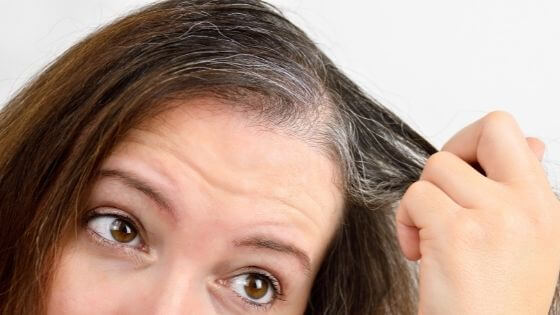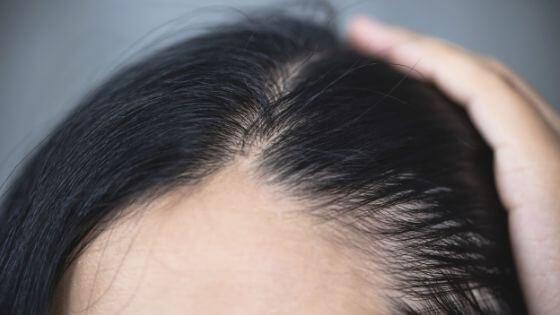The Ugly Truth About MARIE ANTOINETTE SYNDROME!

Has your hair suddenly turned white for no apparent reason? It's not just you. This Marie Antoinette Syndrome is when people develop sudden white hair and are usually caused by an autoimmune disorder or medication that suppresses the immune system.
According to a note published in 'Archives of Dermatology,' the cases of people like Queen Marie Antoinette of France who are executed before their time is not a new event. For example, in 1535, Thomas More suffered from erythema multiforme before his execution. Some survivors during World War II also experienced this skin condition as they were being taken into Nazi death camps.
The syndrome has also been hereditary in some cases, which can manifest as early as adolescence. You may start with a single patch of white hair on your head, but it will continue to spread if left untreated. Remember: "The best time to plant a tree was 20 years ago; the second-best time is now." Act now before it's too late!
- Who was Marie Antoinette?
- What is Marie Antoinette syndrome?
- Marie Antoinette syndrome causes
- Is marie antoinette syndrome reversible?
- Can a person's hair become white from shock?
- Can hair really turn white overnight?
- Can white hair due to stress be reversed?
- Why does hair turn white after trauma?
- Can white hair turn black again?
- 6 Natural remedies for white hair
- Conclusion
Who was Marie Antoinette?

Marie Antoinette was born in Vienna on November 2, 1755. As a Habsburg Princess and Archduchess of Austria, she became Queen Consort of France at the age of 18 but lived as if it were her prison for much longer than that.
Daughter of Austria's emperors, Francis I and Maria Theresa, married in 1770 with the dauphin of France, Louis, who ascended the throne in 1774 under Louis XVI. A frivolous and fickle woman with expensive tastes and surrounded by an intriguing clique, she soon gained a reputation as a reactionary and spendthrift.
Her husband Louis XVI would often absent himself from Paris to spend time with his mistress Madame du Barry. At the same time, Marie Antoinette made sacrifices for him, including wearing expensive dresses and getting involved in French politics, which led to the Revolution where they both lost their heads; Literally!
What is Marie Antoinette syndrome?
Marie Antoinette syndrome or Canities Subita is a severe condition in which people's scalp hair suddenly turns white, because of the decreasing of melanocyte stem cells. It may be the result of going through traumatic experiences. The name alludes to French Queen Marie Antoinette, who had her hair turn completely white during her walk towards death by guillotine.
Marie Antoinette Syndrome can be caused by high levels of emotional stress, which causes less pigmentation in the hair. This is often seen as a basis for most uses of this idea in fictional works about royal families and kingdoms where power resides with one ruler or family.
However, it's important to note that not all people who have lower than normal pigment suffers from this syndrome.
Gray hair is a natural process of aging. It’s not something that only happens when you get older. However — many people start losing their melanin pigments in early adulthood due to alopecia areata type 1 (which can also lead to sudden and complete baldness).
Despite how it may seem at first glance, graying hair isn't just an issue for those who have reached old age. Alopecia areata type 1 sufferers often lose the pigment responsible for differentiating between brown or black hairs from gray ones around adolescence - meaning if they live long enough to reach 70 years of age, there's a good chance most will be going through what we commonly consider "old person problems.
Marie Antoinette syndrome causes
What causes Marie Antoinette Syndrome? Now I am going to tell you the most common reasons:
Alopecia areata
The main cause of this supposed sudden hair color change was a particular type of alopecia areata, today better known as Marie Antoinette syndrome.
Experts explain that far from being sudden graying, what happens is the hair falls out abruptly. First, the darker hairs so when gray hair already there before becomes more visible and gives the greater sensation of sudden graying.
Stress
Although the cause of Marie Antoinette syndrome is unknown, it has a genetic basis, and stress most likely plays an important role. "Despite not having been proven with objective evidence, it can influence as a triggering effect and the same way around; that hair loss causes stress which in turn becomes a vicious circle."
Marianne's last months were filled with anguish due to her imprisonment by the French revolutionaries who accused her of treason.
During the last months of her life, the anguish and stress she suffered accelerated her alopecia, whereby the immune system cells destroy the hair follicle. Periods of stress can trigger new attacks, but always in those who are already predisposed.
Genes
Studies show that if you have a family history of premature hair whitening, the chances are high that you could be at risk for suffering from Marie Antoinette syndrome. There is also a gene called IRF4 which may play an important role in this condition as well.
If your genetics predispose to premature graying, reversing color changes can become more challenging than what would normally take someone without these genes experiencing such effects on their hair's pigmentation.
Vitiligo
Vitiligo is a disease that can cause your skin to lose its pigment, resulting in white patches. This can result in hair loss as well, causing the gray hairs you once had to disappear over time after treatment has stopped.
For example, in 2015, researchers published a case report of one man with gray hair on only one leg. He had no pain or skin discoloration and otherwise was healthy. Doctors were unsure of the cause but suspected it could be an early sign of vitiligo.
Lack of vitamin B12
White hair is a telltale sign of vitamin B-12 deficiency. You can help reverse the damage by getting enough nutrients, but it's important to work with your doctor and registered dietitian you also lack those particular vitamins.
The premature greying of the hair and skin due to vitamin B12 deficiency is reversible if you increase your intake. Vitamin supplementation may not be enough, as melanin production relies on a complex process that can't currently be replicated in lab conditions.
Cell production of hydrogen peroxide
Scientists have long been puzzled as to why hair turns gray. It has now come to light that perhaps the cells responsible for producing melanin also produce hydrogen peroxide, commonly used by people who want their hair color changed.
A groundbreaking enzyme, catalase, can prevent hydrogen peroxide from affecting pigmented strands of hair—at least until we start to get older. Like melanin, the body also produces less catalase as we age. It’s been suggested that the combination of less melanin and more hydrogen peroxide is a mechanism through which our once-black locks become pure white!
Hormonal changes
The hormonal changes that can provoke Marie Antoinette syndrome include thyroid disease, menopause, and drops in testosterone levels. Your doctor may prescribe medications like hormone therapy to help even out these hormones, so you don't have any more emotional meltdowns or premature hair whitening!
Is marie antoinette syndrome reversible?
Can Marie Antoinette syndrome be reversed? The evolution in Marie Antoinette syndrome cases is not always the same and cannot be predicted. Most patients (70%-80%) spontaneously recover their hair with its usual characteristics. But the rest experience periodic attacks of more severe bald patches until they lose all of it or go completely bald on top, losing hair from every part of their body.
It's important to consider the clinical form and general condition of someone with a disease before choosing an appropriate medication. This is often dependent on whether you want to stimulate immunity or depress it, so there are drugs available for both uses.
Can a person's hair become white from shock?
The answer is NO. It is one of those many myths we have always heard about hair whitening, but scientifically, it is impossible. Even if an illness, injury, or sudden shock turned your hair white, it would take weeks before the effect was visible because only the roots are affected.
Scientists have found that the whole hair shaft can't turn white from shock. Rather, white hairs are just left behind when colored ones randomly fall out (for example, due to a medical condition like alopecia).
Can hair really turn white overnight?
It's not that you're going to wake up and find your locks have turned color overnight. Hair can't actually do this because all the cells in it are "dead," so they remain their natural shade of black without artificial or natural substances.
The only way a person can change the tone of her strands' pigment is through dyeing, but even then, there will always be some level of melanin pumped into them from those base-of-hair follicle cells. And as long as these few remaining live parts exist, hairs cannot become entirely gray or albino!
Stories of Marie Antoinette's hair whitening before her death are still told to this day, despite being common knowledge that such a thing is impossible.
Can white hair due to stress be reversed?
Graying, once the hair loses its pigment due to stress-induced, the whitening of hair can only be reversed if there is a change in lifestyle habits. Other factors such as genetics and smoking or catalase deficiency will also cause graying, but reversing this process with other measures like eliminating anxiety may not work.
Including limited amounts of calf liver in your diet combined with fruits and vegetables containing catalase is the best way to reverse the whitening of hair. Avocados are a rich source of this enzyme, but they're too high in fat content for daily use!
Why does hair turn white after trauma?
Stress is not the only factor for the sudden whitening of hair. Recent studies have discovered that it triggers a release of norepinephrine from the SNS neurons. This neurotransmitter subsequently activates the mass migration of stem cells, and it is this process directly connects anxiety to hair graying.
Acute stress has been traditionally viewed as beneficial for an animal's survival. In this case, however, acute stress causes permanent depletion of stem cells. It is unclear whether the process of age-related hair whitening can be accelerated by stress. Is this merely an amplified version of what happens to many people over several decades?
Can white hair turn black again?

The long-held belief that stress turns hair gray has finally been scientifically proven. What's more, according to researchers, we can reverse this process! Including an adequate amount of B vitamins in the daily diet allows the follicles on your scalp to receive sufficient oxygen and promotes melanin production, which will help return your color for a healthy head of strands.
Hair falling out or being shaved off can turn black again! When white hairs grow back in, they might contain melanin pigment. If you stop the activities causing extreme emotional and mental stress, your hair will change color to black due to not experiencing this high level of anxiety anymore.
As a result of genetic or natural aging, white and gray hairs won't turn black again without dye. Yet you can change the color to black using semi-permanent hair dyes.
6 Natural remedies for white hair
Onion
The onion is useful for giving dishes flavor; massaging the scalp with its juice can help stop grey hair. The scientific evidence points to catalase, an enzyme of the onion capable of reducing hydrogen peroxide, which accumulates in follicles and decolors hair.
Avocado
The avocado has more than one use, and not just in guacamole. It contains minerals, fats, and vitamin E with the properties of restructuring hair cells, moisturizing them, or preventing oxidation, leading to premature aging. To enjoy these benefits, you need to grind a ripe unit into paste form, then apply it onto scalp skin for 20 minutes before rinsing off thoroughly.
Henna
The henna, also known as 'Alheña,' is the powder created by grinding leaves from a plant called Lawsonia Inermis. In India, it's prevalent for giving hair colors because of its natural qualities. If you want to use it on your own hair, then mix some water with the dust until you obtain a uniform paste and apply it to one's head.
Walnut leaves
Walnut is a marvelous tool for dyeing gray hair. Boil water, and when it reaches boiling point, add two handfuls of the leaves from this tree to extract juglone, which makes an excellent cosmetic product. Allow them to simmer for fifteen minutes before cooling, then apply these boiled leaves onto your scalp or head if you have desired coloration results that are not achievable with natural pigments alone!
Sage
Hair dyeing has been a popular practice for thousands of years. Among the various herbs used in hair dyes, sage stands out as being especially good at coloring dark locks and covering up gray hairs if applied properly. First, boil some leaves from this herb for 30 minutes to extract their colorant properties, and then apply them over your head once they have cooled off completely.
Ginger
The secret to healthy hair is to have a clean scalp, and ginger may help with this. This should be because it will increase circulation on the scalp and promote new follicles' growth. Boil water, then when boiling, add grated ginger. Let simmer for 15 minutes before applying directly to the skin area.
Conclusion
I hope you enjoyed the article on Marie Antoinette syndrome and found that it cleared up all your doubts. If there's anything else I can do to help, please contact me with any questions about this topic!
